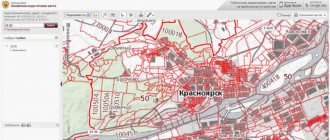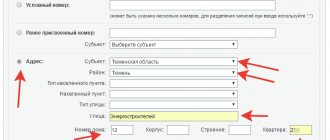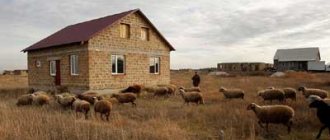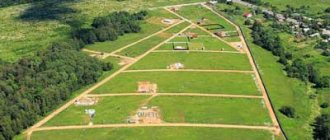The most in demand for the construction of buildings are lands that are part of populated areas (SNP).
But before choosing a construction site, you need to know:
- what territorial zone they belong to;
- what type of permitted use (AUR) they have.
There are lands where:
- you can build without restrictions ;
- can be built with certain restrictions;
- can't be built at all.
Inappropriate use of land can lead to:
- recognition of the building as unauthorized construction;
- refusal to register ownership of the building;
- demolition of the building.
What is ZNP?
The Land Code of the Russian Federation has defined 7 possible categories of land:
- state reserve;
- water fund;
- forest fund;
- natural objects under state protection;
- special purpose;
- agricultural purposes;
- settlements.
Article 83 of the same code determined that ZNP recognizes those lands that do not extend beyond the boundaries of a populated area and are intended for its construction and/or infrastructure development.
The establishment of these boundaries is regulated by Article No. 84 of the Land Code of the Russian Federation.
The right to change them belongs to:
- federal authorities;
- local authorities;
- courts, as part of resolving an issue in a particular proceeding.
Personal subsidiary farming - what does it mean?
What is a plot for private household plots, what is it and how can it be used? Personal subsidiary farming is a type of permitted land use. You can see the full VRI classifier in another article.
According to current legislation, this term refers to a plot of land used for farming for its own (non-industrial) purposes.
One specific person alone or together with his family (relatives) has the right to engage in farming without restrictions.
By housekeeping we mean:
- growing agricultural products;
- its processing;
- livestock breeding;
- breeding poultry.
Non-industrial use, does not prohibit the owner of the site from selling surplus products .
In addition to the type of permitted use, there is an even broader concept - the category of land.
The legislation of the Russian Federation provides for 7 such categories, of which only two attract our attention:
- Lands of populated areas (LNP).
- Agricultural land (ZSN).
Private household plots may be part of one of these categories , and their intended purpose will differ significantly from each other.
Private household plots that are part of the ZNP are called household plots, and those that are part of agricultural land are called field plots.
How can you use your garden plot?
VRI homestead farming is most common in rural areas and urban settlements. It is also found on the outskirts of large cities.
The Land Code of the Russian Federation determined that ZNP should be used for the development and improvement of populated areas.
In accordance with this, on a personal private plot, the owner has the right :
- erect residential buildings and utility rooms:
- grow garden crops;
- garden crops;
- floriculture;
- raise livestock and domestic animals.
For detailed information, read the article about private household plots.
What can you do on the field
In turn, the field plot of private household plots can only be located outside the border of a populated area .
As an example, land plots allocated to villagers for planting potatoes, grain and other crops.
Federal Law No. 112 determined that the field plot of a personal subsidiary plot is intended exclusively for agricultural needs .
Here you can do everything that you can do on a private plot of land, in addition to erecting any buildings.
For detailed information, read the article on field private plots.
Main types of permitted use by zone
The division of settlement lands by types of permitted use is regulated by the VRI classifier. All lands of settlements are conventionally divided into large territorial zones.
The following main zones :
- residential buildings;
- public and business buildings;
- entrepreneurship;
- recreation;
- public use.
Each of the listed zones includes several VRIs at once.
Residential
The zone of residential buildings includes types of permitted use of land plots in settlements for the construction of residential buildings with codes from 2.0 to 2.7.1:
- blocked type - townhouses;
- mobile type - camping sites, tent cities;
- mid-rise - apartment buildings up to 8 floors;
- high-rise buildings - high-rise buildings;
and also for the construction:
- individual residential buildings (IZhS) - private houses, cottages;
- domestic buildings - utility rooms, garages;
and running a personal subsidiary plot (LPH) - a private house with a plot intended for:
- garden,
- garden,
- livestock breeding.
Public and business
Includes lands of settlements with types of permitted use for the provision of services with codes from 3.0 to 3.10:
- utilities,
- social,
- medical,
- veterinary,
for creating:
- places that promote cultural development;
- educational institutions;
- religious centers;
- centers of scientific activity;
- management centers.
Entrepreneurship
Includes lands of settlements with permitted use for the creation of :
- business management centers;
- shopping centers, shops and markets;
- commercial and insurance organizations;
- catering outlets, hotels (hotels) and places of entertainment;
- vehicle service locations.
Rest
Includes types of permitted use of settlement land to create:
- sports facilities;
- tourist facilities;
- playing fields and walking fields;
- berths intended for yachts, boats, etc.;
- places for fishing and hunting animals.
Common use
The common use zone includes the types of permitted use of land plots in settlements to create:
- highways,
- pedestrian sidewalks,
- public water bodies
- parks and squares,
- cemeteries, etc.
What land can you build on, categories and types of permitted use
In the event of such changes, it is necessary to include the land plot within the boundaries of the settlement, that is, in fact, to change the boundaries of the settlement. In addition, the state will have to compensate for losses in agricultural production. Such actions may not be economically viable. In this situation, you can not change the category of land, but change only the intended purpose, for example, to determine it for dacha farming or gardening.
Suppose, if you purchase a plot of land classified as agricultural land, then it may or may not have development rights, then it may or may not have development rights, or for gardening, country house construction, peasant farming - in all cases, construction can be carried out, but only under different conditions.
We recommend reading: Civil Code of the Russian Federation inheritance order
Additional terms and restrictions
The issue of granting a site with the land category “land of settlements” permitted auxiliary or conditionally permitted use is decided by local authorities .
If approved by the land use commission, one land plot can be given up to three VRI:
- basic,
- conditionally permitted,
- auxiliary
The basis for determining the main type is the possibility of using the land of a settlement with maximum efficiency .
That is, if the site is located in the zone of residential buildings, then it is advisable to allow construction there:
- Houses,
- store,
- educational institution.
If the owner of the site considers that the plot is being used ineffectively, he can submit a request to add a new VRI , which will have the status “Conditionally permitted”. To do this, it is necessary to agree on the change with the land use commission through public hearings.
All interested parties are involved in the consideration of the case:
- representatives of the locality administration,
- owners of nearby plots,
- the petitioner himself, etc.
Conditionally permitted VRI can be used as the main one or in conjunction with it. That is, if the commission approved the provision of a new VRI, you can build a house and a store on the individual housing construction site, or you can only build a store or just a house.
An auxiliary type of use involves the construction of structures on the site that do not go beyond the scope of the two VRI described above.
For example, when constructing a residential building on an individual housing construction site, outbuildings will be auxiliary VRI.
For the construction of objects that fall under the auxiliary construction permit, a building permit is not required .
Auxiliary VRI can only be used in conjunction with the types described above.
The project for a future building must be coordinated with the land use and development rules (PLR) and urban planning regulations, which are adopted at the local government level .
In most places, these documents prohibit the construction of buildings that will affect the safety of neighboring structures. For example, you cannot build a house closer than 1-3 meters from the border of the site. Failure to comply with this requirement may lead to the recognition of the construction project as unauthorized construction .
Also, other violations of the PZZ and town planning regulations may lead to the recognition of a residential building as an unauthorized construction.
There are two options:
- Demolition of an unauthorized building at the expense of a person who violated construction standards.
- Return of the developer's ownership of the building through the court.
Limit dimensions
Article 11.9 of the Land Code determined that the minimum and maximum dimensions of a plot are established by local town planning regulations .
This is also confirmed by Article 38 of the Town Planning Code, which states that, among other things, town planning regulations must contain:
- Limit sizes of allotment;
- Minimum setback from the property line to the building (house, barn, garage, etc.);
- Maximum number of floors (heights) of the building;
- Possible percentage of development of the site.
That is, the maximum and minimum sizes of plots are established by the administration in charge of these lands. This could be the administration of a village, the administration of a city, the administration of an entire subject of the Russian Federation, etc.
Most often, only the minimum plot size ; it makes no sense to determine the maximum, since one person can purchase several plots at once, thereby doubling their area.
Taking into account the requirements put forward by the main regulatory documents (SNiP, fire service requirements), the minimum area of the garden plot is 3 acres . This area allows you to move the house to the required distance from the neighboring plot and from the road.
What VRI is needed to build a house?
Private construction of a residential building on a site classified as “land of settlements” allows the following types of permitted use:
- individual housing construction,
- private household plots,
- blocked residential building.
Let us tell you in more detail about each of the VRIs listed above.
Individual housing construction
It is allowed to build a house with a total number of storeys, excluding basement floors, no more than 3, a garage and utility rooms. The house is exclusively single-family. Within the site you can engage in gardening and gardening. You can read more about individual housing construction in this article.
Personal subsidiary plot
It is allowed to build a house with a total number of storeys, excluding basement floors, no more than 3, a garage and utility rooms. The house is exclusively single-family.
Within the area you can do:
- gardening,
- gardening,
- cattle breeding.
You can read more about private household plots here.
Private household plots within a populated area and private plots on agricultural lands are different things and different VRI.
In the first case, a house can be built without restrictions, in the second, it can be built in agreement with the land use commission and provided that the allocated plot will be constantly cultivated and used for its intended purpose.
Therefore, it is worth finding out the VRI and category of the site in advance. There are several ways to find out which category of land your site belongs to, the simplest of which is by cadastral number. Read more about which category of land is more suitable for building a house or cottage here. The information from the article “What is the difference between individual housing construction, SNT, and DNP” may also be useful.
Blocked residential building
It is allowed to erect several single-apartment houses adjacent to each other, with a maximum number of storeys, excluding basement floors, no more than 3, a garage and utility rooms.
Within the site you can build:
- garden,
- flower garden,
- garden.
Nuances on legal aspects and some features of the issue
If you decide to take a plot, then, most likely, you will come across many incomprehensible terms, and not only the process of registering a plot, but also its price largely depends on how clearly you distinguish the difference between one or another concept.
Types of land use
For clarity and to improve the perception of information, we will present all data on this issue in the form of a simple table:
| Plots for individual housing construction (IHC) | According to the law, one detached residential building with a height of no more than three floors can be built on such a site. In such a house, registration at the place of residence is possible without any problems; we can say that this is the most popular and widespread option in our country, used by most developers |
| Plots of land for personal subsidiary farming (LPH) | There is one important nuance here: if the land is located within the city, the plot is considered a personal plot, and a residential building can be erected on it. If the plot is located on agricultural land, then it is classified as field land, and the construction of residential buildings on it is prohibited by current legislation |
| Country construction | This option is different in that it can be used for various purposes. Therefore, it is worth studying the documents especially carefully; if they indicate that this is a summer cottage with the right to build a residential building, then you will be able to register after construction, but if the documents indicate the right to a residential building, then you cannot register in this place |
Important! When choosing one option or another, it is worth remembering that you can often buy a summer cottage plot one and a half to two times cheaper for the same area. This is a very important factor, because if you can build a residential building on the land, then it is, in fact, no different from individual housing construction or private household plots.
Features of the allocation of land in settlements
The action plan is as follows:
- The plot of land must be owned by a partnership, legal entity, individual or group of persons. It is important that all necessary documents are present.
- Next, you need to contact the administration, which must write a petition to the head of the administrative unit in order to obtain permission for a certain type of use without changing the category.
- A date is set for public hearings, during which a change in the type of use of a particular plot of land will be discussed. This event is reported in the media so that all interested parties know about it.
- On the appointed day, hearings are held in the administration of the territorial unit; a secretary is appointed from among those present, who draws up a protocol in which all the issues discussed are noted and the data of all those present is recorded. The finished document is signed by the chairman of the commission, usually the head of the municipality.
- A few days after the hearing, all interested parties are given a special conclusion, which sets out all the results. The document must be signed by the district leadership. The results are also published in the media.
- Next, the documents are sent to the nearest structural unit of Rosnedvizhimost, which is taking a number of measures to change the type of permitted use of the site. The procedure is quite lengthy, so you will have to wait a very long time for the result, but it is unlikely that you will be able to do all the procedures faster. When all issues are resolved, the owner is issued an act of determining the cadastral value.
- Next, you need to submit documents to the regional departments of Rosnedvizhimost so that they change the type of cadastral registration in accordance with the new purposes of use. The authority must issue you an extract indicating that the type of use has been changed and the site can be entered into the unified state register.
- And finally, the last stage is obtaining an official certificate of ownership of the site indicating the new purpose of use. In fact, if changes are made to the cadastre, then there may not be a certificate. All the same, in the database you will be the owner of the land, and no one will be able to challenge this right if all procedures were carried out without violating the law.
This is how land in populated areas is allocated for dacha construction. As you can see, the process is not easy, but quite feasible.
And then you can start construction; first of all, you should take care of connecting communications; if they do not exist yet, then such a type of service as renting a diesel generator for a summer house will help to do the work of pouring the foundation.
Suitable VRI for doing business
The “Entrepreneurship” zone is suitable for the construction of business facilities.
For private business, it is best to use the following types of permitted use of land plots in settlements:
- the shops,
- catering points,
- hotels,
- automobile service stations.
For the construction of shops. Construction is permitted not exceeding 5000 square meters. The building can be used to sell goods of any type. If it is necessary to open a cafe at the same time as a store, the land use commission must be asked to add a conditionally permitted VRI “Public Catering”.
For the construction of catering points:
- canteens,
- restaurants,
- cafe,
- other places where you have to pay for food.
For the construction of hotels:
- hotels,
- hotels,
- boarding houses,
- other places that are buildings to provide visitors with a comfortable stay in them - recreation, but in which medical services are not provided.
For vehicle maintenance:
- car services,
- sinks,
- gas stations, etc.
conclusions
Let us briefly outline the main points of the article:
- ZNP are intended for the development of the city/village, including the construction of residential buildings and business facilities.
- All RFPs are divided into 5 main categories . It is better to build residential buildings in the residential buildings zone, and business facilities in the business zone. But in agreement with the local administration, the issue of providing the plot with another VRI can be resolved.
- One plot of land can have several types of use at once . This means that, if approved by the land use commission, business facilities can be built in a residential zone, and vice versa, a residential building can be built in another zone.
- When constructing a building, it is important to comply not only with zoning, but also with the standards established by local documents. Failure to comply with the rules may result in the building being declared an unauthorized construction.
Construction of objects with the status of “Agricultural Land”
If we talk about VRI “Gardening”, the classifier does not make any distinctions in terms of possible construction for ZNP and ZSN lands.
Construction is also allowed here :
- Country houses, summer houses, intended also for recreation;
- Other structures necessary for conducting economic activities: sheds, storerooms, etc.
Regardless of the conditions created in the house, the presence of all kinds of communications, the presence (absence) of another home with the owner of the plot, it is impossible to register on ZSN land.
Read more about the features of gardening in separate articles:
- gardening on the lands of populated areas,
- on agricultural lands.








